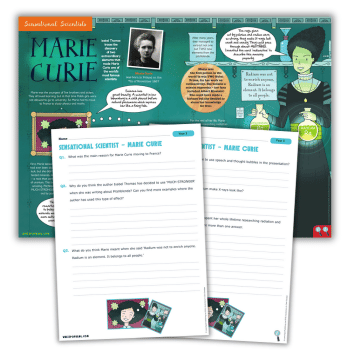5 PDFs: one factfile, plus two worksheets and with answer sheets
KS2
Year 3
This Year 3 reading comprehension resource includes a Marie Curie fact file from Whizz Pop Bang magazine.
There are also two question sheets, one for lower-ability pupils and one for higher-ability pupils, plus answer sheets for both.
Sample Year 3 reading comprehension questions
- Why did the author choose to use speech and thought bubbles in the presentation?
- What did polonium and radium make X-rays look like?
- What was the main reason for Marie Curie moving to France?
- What do you think Marie meant when she said ‘Radium was not to enrich anyone. Radium is an element. It belongs to all people.’
Who was Marie Curie?
Marie Curie made groundbreaking discoveries in the early 1900s. She uncovered two new elements, radium and polonium, enriching our understanding of the building blocks of matter. Her work on radioactivity revealed the powerful energy hidden in tiny particles.
Marie wasn’t just a scientific genius; she also broke barriers by becoming the first woman to win a Nobel Prize. Her contributions paved the way for women in science. Marie Curie’s legacy reminds us that curiosity and determination can lead to extraordinary achievements, making her a trailblazer in the world of scientific exploration.
Whizz Pop Bang is an award-winning science magazine that brings science to life for children aged 6-12. Browse more KS2 reading comprehension resources.














